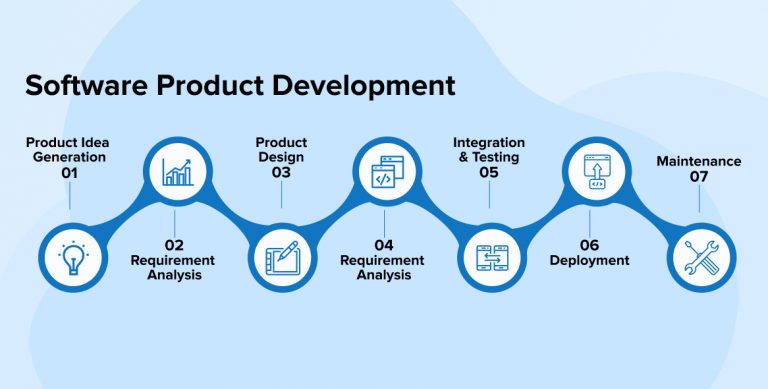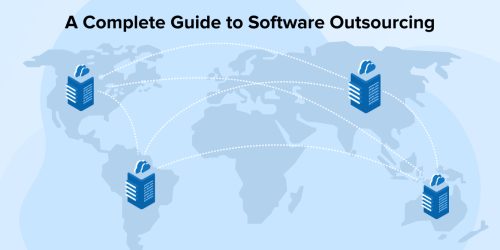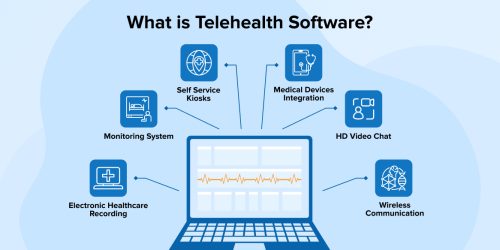Related Blogs

After the discovery of newer ways of product development, leading businesses are now experiencing a eureka moment. They are discovering naïve ways of software product development. All of a sudden they will now be able to envision their products through a completely different methodology. The way software development has expanded its horizons and now we have product development as a new approach to develop applications. Frankly, creating a software product needs a properly planned approach. After Google introduced the concept of prototyping, many businesses have been adaptive to this concept and developing apps on a collaborative platform.
Now businesses can test multiple product features and make sure the end product meets the dynamic user requirements. This implementation and test feature of product development has enabled multiple businesses to introduce newer products soon and make changes in the product in a cost-effective way. Everyone in the existing market knows that newer products are sold like hotcakes so if you want to make your product unique and different from the breed, you must timely update with the market and consistently introduce innovative changes and new features into your existing product. This blog is a guide for all businesses who don’t know the processes involved in software product development and on the other hand, it will also be an insightful guide for businesses who know and understand software product development terminology, its development stages, and different types of product development methodologies.
1. What is Software Product Development?
Software Product development is the process of creating a new product with some added value and features. It can be anything from developing an entirely new product, or upgrading an existing product, or improving the process, technique, or development methodology of the system. To put it another way, With newly developed software products we can bring change in the current market and give users a better customer experience. Development and innovation pave the path for new product innovations and it will benefit the customers. Software product development is a methodical, and steady process that aims to represent a certain personal or business purpose, technique, or goal. It usually takes a comprehensive approach that includes several software development phases or procedures that culminate in the construction of a working software product.
Software developers also integrate a set of third-party tools and features while developing a software product to meet certain market needs. It helps to improve existing processes, techniques, methods, and overall customer experience. Existing production processes, methods, techniques, and systems might all be upgraded to improve customer experience and satisfaction. It also costs less for the organization.
2. Why Does Software Product Development Matter?
Here are some reasons why software product development is important.
2.1 Business Process Optimization
Every company has its own business strategy and internal procedures. Changing these procedures to fit a given application or software product, no matter how efficient or powerful it is, is difficult. As a result, software product development helps the company to smoothly work with its internal processes, business strategy, and system requirements and optimize business procedures.
2.2 Offers Competitive Edge
When you are developing an application, it is quite important for your business to see what works in the market and what doesn’t. Your business must have some unique characteristics that work differently. The business should employ a solution that provides a significant edge over its competitors. Software product development enables businesses to create a product that has unique features and processes developed from unique ideas which can give them a competitive edge.
2.3 Customized Solution
There are some things that may work for one company but may not work for another. As a result, designing a bespoke software solution for your company ensures that it handles unique procedures and activities that are exclusive for your business requirements. There is ready-made software available in bulk that may support your business activities but not completely. Many businesses are using it but it would be more efficient if you know your custom business needs and create a software product based on those intended requirements. This has wider benefits than you have ever thought of. Benefits such as improved process efficiency, focused solutions, faster results, and many more one can get from custom software product development.
3. How to Initiate a Product Development Plan
Now, let’s understand what it takes to create a Software Product Development Plan.
3.1 Envision a Product
It all starts with a product vision, which can bring everything to one place with a common goal. The product vision—the product’s ultimate goal, who it’s for, and what it accomplishes for them—is next presented. Finally, it lays down certain ground rules for future development.
Primary goals for the product may be developed once the product vision and mission statements are in place. These may be a little hazy at first, such as determining product-market fit, but they may quickly grow into quantitative KPIs or OKRs. These quantifiable goals aid in determining which features, additions, processes, and capabilities the product will require to meet them.
3.2 Create a Roadmap
You must have a blueprint before the execution of the action plan. After doing the actual customer requirements analysis and validation, the product team may create a product roadmap that prioritize the major topics to be addressed. You can plan the schedule as per the date-based milestones and defined targets. The focus should be on delivering value and responding to product goals and performance against key indicators rather than on dates.
3.3 Roadmap Implementation for Maximum Impact
It’s time to put the product strategy into place after everyone has agreed on it. Implementation teams may make timetables, divide major topics into sprints, and establish product iterations. The input of customer surveys, the sales staff, and support all provide input, discovering new opportunities, pointing out flaws, and highlighting areas to sharpen, enhance, and grow. Several key documents such as product design documents, and software requirements specification documents are prepared forthe implementation of the roadmap.
From then, it’s a never-ending cycle of examining data, aggregating input, and constantly revising the product roadmap while grooming the product backlog to ensure that every software development life cycle is put to the best possible use.
4. Software Product Development Steps
Let’s have a detailed look at a step by step process of software product development.
Stage 1. Product Idea Generation
Product idea discovery is the first step in the software product development lifecycle. Everything begins with a brilliant concept! However, in order to implement, that notion must be thoroughly considered. The first and most important phase in software product development is careful planning, which includes determining the project’s scope, and outlining how the new software product will achieve business objectives, cost-related challenges, resource availability, and timetables.
When you decide to develop a software product, it must answer the needs of the market which means it should specify what difference it will bring in the market or in the lives of the customers.
There are products developed after specific research and analysis of target customer requirements. You can examine, utilize, and evaluate related software products and then decide to create your own software. This is just an ideation phase, the validation of the idea will be in the next stage.
Stage 2. Requirements and Feasibility Analysis
Now that the idea of product development is approved, it’s now time to analyze the requirement feasibility. A feasibility study for a project performs a full examination of how the project will be carried out throughout this stage of software product development. From a practical point of view, the study is carried out and analyzes whether this product will bring impactful change within the organization or not. This process will define the product needs, design and codes, resources, and other areas contributing areas to develop an actionable solution.
All of the technical and financial components of the software development process are highlighted in the requirements and feasibility study. It aids in the early identification of the perils of software products. With this, you can take an early step and devise risk mitigation methods as per the requirements.
Stage 3. Product Design
A significant part of the software product development process is product design. During the design stage, the organized software architecture fulfilling specified project criteria and requirements is produced, which is where the real conceptualization of the software system takes place.
Developers create specific procedures and standards for customized software products. The prototype design and representations are used to create the whole program structure during the software product development process. Once the design has been identified, it’s time to move on to its creation.
Stage 4. Product Development and Coding
In the software product development steps, this process takes place after designing. This phase is the heart of software product development. The product development initialization starts from this phase. Within the software product development process, this step includes writing code and turning design papers into working software. Because it is a core and complex process, this stage takes the longest time to develop when compared to all the other stages. Software developers make sure that their code adheres to the software requirement specifications as well as the demands of the stakeholders.
When it comes to developing a software product, the development teams can create and implement their development roadmap. You can summarize and communicate with their plans so as to build a robust and standard high-performing software product. Also, the arrival of new development tools and technical improvements improved development process efficiency and enhanced scalability of software products.
Stage 5. Integration and Testing
Now that your product is built, it’s time for it to undergo the testing phase. It involves system continuous integration, functionality testing, system testing, and interoperability testing, as well as user acceptance testing, all done by the software testing team. In this phase, you need to thoroughly examine the software product. You must ensure that whatever plan you create, the developed software product is as per that or not. Once you complete this, you can integrate all the features of the application into one resilient system. This system will be later tested and applications will be checked for a smooth flow of apps. A balanced mix of manual and automated testing can speed up the release process. This guarantees that the code is free of errors and that business goals with this solution will be met.
Stage 6. Test Marketing and Launch
When it comes to software development, deployment refers to the process of preparing an application in the market for delivery. Planning, development, and operation must all work in tandem to provide a trouble-free and smooth deployment. Every critical part of development should be known to the operations team. As a result, you’ll want to ensure that everyone in the organization is on the same page. After deployment, the product will be available in the market for users to use. The next step is to launch these developed products. Software product launching will be done after doing a hundred checks to ensure it is ready for deployment. After this, the next step is to begin creating a marketing strategy or a product promotion plan.
Your developed app should be made public with all of its wonderful characteristics and features. You may even test the market with a minor product launch. You might change your plan for the major launch depending on the outcomes. You may also evaluate your marketing plan and, if it works, scale it up. At this point, there is still a lot of work to be done, as you must select how many goods will be offered.
Stage 7. Maintenance and Support
Now if you think your job is done once the development process is over, then it is probably a wrong notion. The job still continues until the software demands constant upgrades and services. The maintenance tasks are also taken up by software development services providers and there is a fixed resource team allocation to resolve the issues if any occur. The support and maintenance service may include bug detection and correction, process upgrades, software upgrades, etc. and these make the product perform bug-free.
Traditionally, there are multiple software product development methodologies in the market today, that would make the development processes improvised and convenient. They offer benefits such as minimized risk and enhanced scalability to continuous iterations. Some of the popular names in product development methodologies include the Waterfall method and Agile methodology. Let’s see each of them in detail.
5. Different Software Product Development Methodologies
Following are the different methodologies used for software product development.
5.1 Waterfall
You can use various methods of software product development. The waterfall model, which was one of the first software development approaches, consists of a set of consecutive steps: conception, initiation, analysis, design, construction, testing, quality assurance, implementation, and maintenance. All the steps always take place in this order and never overlap. Before moving on to the next step, the developer must complete the previous one. The paradigm is suitable for software projects when needs are explicit and thorough, precise, and accurate papers outline how the system will be built since it assures unique goals are met. Because its representation resembles a cascade of waterfalls, this model is called the “Waterfall Model.”
5.2 Agile
The Agile product development methodology is an iterative approach to managing software development projects that focuses on managing continuous releases and incorporating customer feedback with every iteration. Software teams that embrace agile methodologies have chances to increase their development speed, expand collaboration, and foster the ability to better respond to market trends. In agile methodology, you can also include newer upgrades, and releases which enables clients to see and access frequent changes very easily. More product features may be tested, added, and tested again after obtaining consumer input at each level of the product development process.
Incremental development is also a type in the Agile development paradigm. The creation of software is quick in incremental cycles. As a result, the incremental releases made are faster, with each one expanding on the preceding one’s features.
To guarantee that you maintain the software quality, each release needs to undergo rigorous testing. You can employ time-sensitive applications. Agile methodology saves time and promises the end product meets the decided requirement. In agile, you can also use Scrum as a development methodology. Let us see what scrum is.
5.3 Scrum
Scrum is a major part of the Agile development process. The basis of Scrum is dependent on a cross-functional team that self-organizes. In Scrum, a development team is cross-functional, which means that everyone is required to bring a feature from concept to execution. Scrum is a pragmatic framework that focuses on constant learning and adapting to changing circumstances. It understands that at the outset of a project, the team does not know everything and will learn as the project progresses. The design of scrum is to let teams adapt to changing conditions and user needs naturally, with re-prioritization integration to the process and short release cycles to ensure that your team is always learning and improving.
5.4 DevOps
Development combined with Operation is one of the most preferable methods in the product development process. The reason why businesses choose this method is because it is quick, efficient, and qualitative. The amalgamation of development and Operations shortens the life cycle of developing products and provides consistent updates and new-edge features with a goal to meet business agendas.
The process of DevOps involves everything from conceptualization, design development, integration, testing, deployment,t and release. Since that time, DevOps has been undertaking all the responsibilities as a mainstream methodology. Unlike other methodologies, DevOps works concurrently on all modules and builds an application that is open to change even after development and during the development process. It is less time-consuming because it automates some of the essential processes like testing. As a result, companies can easily work on updates and release the product at a faster pace than expected. The main aspect that makes DevOps a favorable choice among developers is that it enhances efficiency while maintaining clean codes without the fear of failure. It comes with a quick recovery plan and fixes the errors or bugs in a go.
6. Conclusion
So, that’s all for this blog, we hope that through this extensive guide on Software Product development, we try to deliver the right information possible. We have shed light on all essential parameters. To avoid product failure and hear the right voice from the clamor space. You must refer to this guide before you choose to develop an application. This definite guide is a one-stop solution for businesses to know and understand what processes participate and which one will suit your business the best. You as a business must know what is new product development, how to create a product roadmap and implementation plan, and ways to achieve desired results.

Kamal Sharma
Kamal Sharma is a VP of TatvaSoft which is a custom software development company. He is an accomplished Business Strategist and Tech Visionary with wide-ranging experience in the technology sector. He leads the business operations of the company and creates vision & strategic goals for his colleagues.
Related Service
Software Product development
Know more about Software product development
Learn MoreSubscribe to our Newsletter
Signup for our newsletter and join 2700+ global business executives and technology experts to receive handpicked industry insights and latest news
Build your Team
Want to Hire Skilled Developers?





Comments
Leave a message...